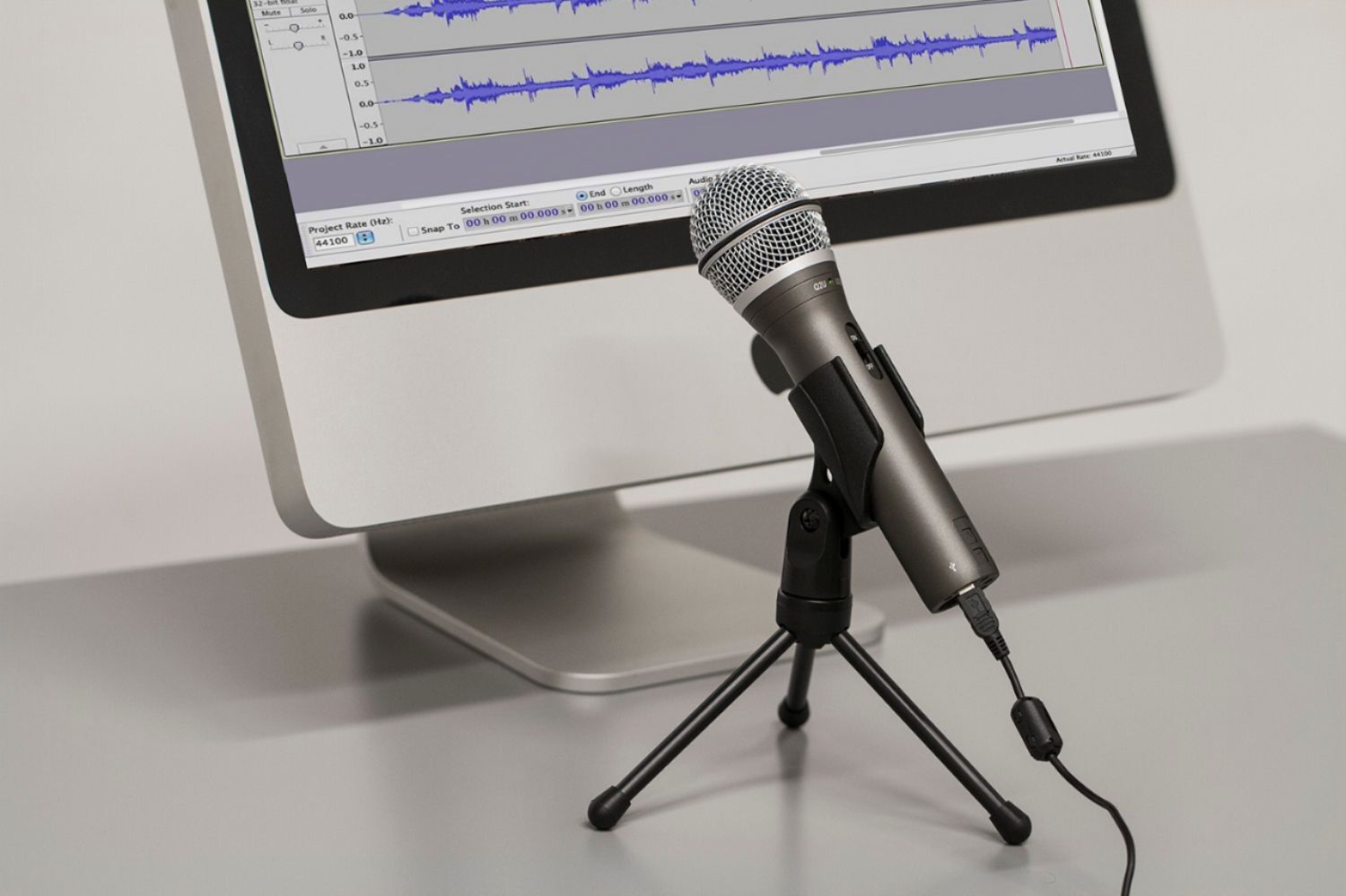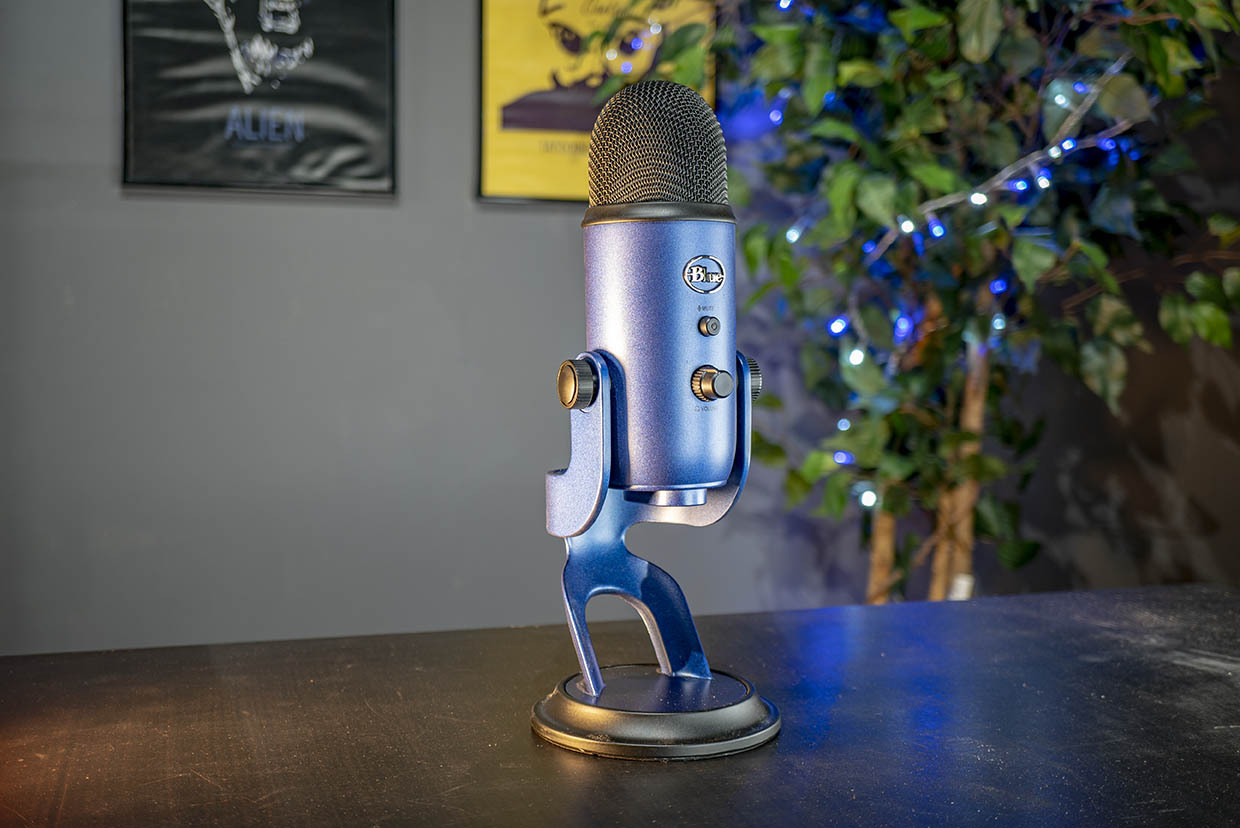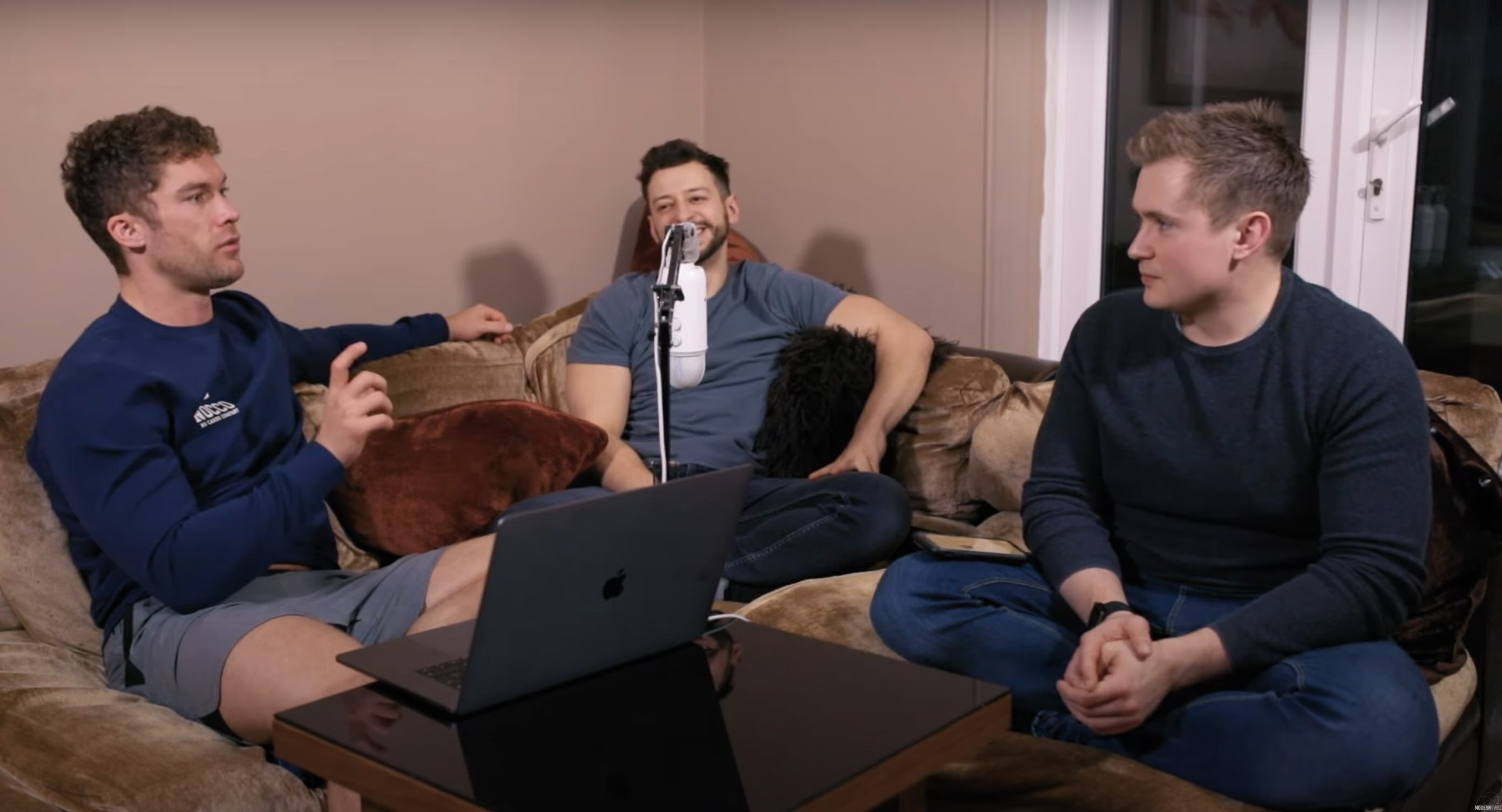“What’s the best podcast microphone?”
We get asked this question at least once a day. And the honest answer is “It depends”. But we know that’s not very satisfying. So this article is our attempt at giving a more comprehensive and definitive response.
The best podcast microphone isn’t always the fanciest or most expensive on the market. Choosing the right one means taking into account your experience level, podcast format, recording environment, budget, and personal preferences. As a result, it’s worth taking some time to shop around and weigh up your options.
To speed that process up, let's narrow things down. We’ve reviewed a lot of podcast microphones, so we know what to look (and listen) out for. Below we’ve outlined our top three recommendations for podcast microphones in three main categories: Budget, Mid-Range, & Pro. So which mics made the list?
Budget (< £100)
- FiFine K669B (USB - £50 / $70 )
- Samson Q2U (USB & XLR - £70 / $90)
- Rode NT-USB Mini (USB - £99 / $120)
Mid-Range (> £100)
- Blue Yeti (USB - £119 / $125)
- AKG Lyra (USB - £140 / $149)
- Rode Procaster (XLR - £150 / $228)
Pro ( > £200)
- Aston Stealth (XLR - £278 / $379)
- Electro Voice RE320 (XLR - £260 / $299)
- Shure SM7b (XLR - £400 / $429)
We’ve reviewed each microphone in more detail below to help you make a decision. We’ve also provided a quick guide explaining some important microphone features and technical terms in plain English. Because nobody likes jargon.
Why Microphones Matter in Podcasting
“Do I even need a microphone to podcast? Can't I use a phone or laptop?”

Technically, yes, you can record your podcast using your laptop or phone mic. But that doesn’t mean it’s a good idea. Remember, most people listen to podcasts using earbuds. If your audio quality immediately offends their eardrums, they’ll leave and won’t come back anytime soon. Internal microphones simply don’t cut it. It’s well worth buying a dedicated one, even if you only have a limited budget to work with.
Podcast Microphone Jargon in Plain English
To make sense of the microphone reviews below, it helps to have a basic understanding of some key terms. The technical side of podcast microphones can get pretty complex, so we’ve tried to keep things simple. Here are the key definitions to keep in mind when reviewing your options:
USB Microphone - These plug straight into a USB port on your laptop or computer. No additional equipment is needed. They’re ideal for beginners as they are incredibly convenient. However the sound quality won’t be as good as XLR mics.
XLR Microphone - Usually podcasters progress on to an XLR mic after they’ve outgrown their USB mic. XLR is the standard connection used in the professional audio world. It has a 3 pronged connector that needs to be plugged into some kind of audio interface like a mixer (not directly into your computer).
Audio Interface - A piece of hardware that expands and improves the audio capabilities of your computer by allowing you to connect a professional XLR mic.
Dynamic Microphone - These provide good sound quality in all types of recording environments, they do not require a power source to run, and are relatively cheap. Great for recording at home or travelling on the road.
Condenser Microphone - Most commonly found in professional studio environments. They are generally more expensive than dynamics, producing a clearer, crisper, and more detailed sound. But they require power to run, pick up more background noise, and are much more fragile than dynamic mics. Not suitable for on-the-go use.
Gain - Adjusting the gain of a mic makes the output louder or softer. Sort of like a volume control (purists may cringe, but it’s a good analogy for us mortals).
Pickup Pattern - This is how well a microphone “hears“ sound from coming different directions. For example Cardioid pattern mics will only pick up sound from directly in front of the mic while rejecting everything else. Other common patterns include Bi-Directional and Omnidirectional.
Plosives - Harsh sounds that P’s and B’s make when spoken loudly into a mic. They can be eliminated with good mic technique or by using a pop filter.
With that short lesson in audio production over, let’s get into some of the best podcast microphones on the market!
FiFine K669B (Budget)
The Fifine K669 USB microphone was designed with value and simplicity in mind. Equipped with its own tripod, the Fifine is convenient and incredibly easy to install on both Mac and PC. It’s also sturdy enough to be chucked in a bag and used on the move. To get the best audio you should stay roughly 10-15cm from the mic and play around with the gain setting to optimise your recording. When up and running your voice will sound nice and bright thanks to some in-built EQ (although this won’t be to everyone’s tastes).

To be completely honest, the FiFine doesn’t deliver premium sound quality. However, it’s still a significant set up from any internal laptop or computer microphone. So if you’re an absolute beginner and you want to test the waters before making a bigger investment in podcasting, it’s perfect for learning the ropes. You can work on improving your mic technique and mastering the fundamentals of recording and editing without having to break the bank.
Samson Q2U (Budget)
The Samson Q2U is the only mic on the list that supports both USB and XLR connectors. It’s a dynamic microphone with a cardioid pickup pattern which does a great job at rejecting off-axis noise compared to others in this price bracket. So if you’re recording in a room that hasn’t been sound-treated, or you’re out in a busy location your audio won’t get cluttered with too much unwanted background noise. The Samson also has a nicer tone than the FiFine and it does a good job of reproducing voices accurately.

Having both a USB and XLR connection means there is a strong case for the Samson being the best beginner podcast microphone on the market. You can get started without any extras, plugging it straight into your laptop or computer via USB.
But if you want to up your game and invest in an audio interface (we recommend the Scarlett 2i2), the Samson can adapt. Switching to XLR will give you a nice boost in sound quality. To top it off, the Samson even comes with its own pair of headphones included for monitoring your audio. In summary, the simplicity, versatility, and accessories make the Samson amazing value.
Rode NT-USB Mini (Budget)
The Rode NT-USB Mini delivers the same audio quality as its bigger brother, with a significant reduction in size. Perfect for those who want to plug in and record anytime, anywhere. Whether you’re recording at home, or need to set up on-location in a flash, the NT-USB Mini makes life easy.
As it’s designed with mobility in mind, the Mini has a built-in pop filter that helps dampen those pesky plosives. The Mini’s directional cardioid pickup pattern means it focuses on picking up sounds coming from directly in front of it. This cuts down on background noise, but doesn’t eliminate it completely - so if you’re recording in a public space, it will capture a nice ambience.
If you need to be prepared to set up quickly and record a podcast anywhere, this is one of the best options on the market right now. It might not have lots of bells and whistles, but it does the basics extremely well. A brilliant compromise between sound quality and convenience.
Blue Yeti (Mid-Range)
The Blue Yeti is one of the most popular USB mics in the world due to it’s sturdy design, versatility, and ease of use. It comes with its own stand attached so you can place it on your desk and start recording straight away. And thanks to its condenser capsules, your voice will sound nice and clear.

Ease of use aside, the Yeti really shines in the flexibility it offers. It has 4 different recording settings - Cardioid, Bi-Directional, Stereo, Omnidirectional. Because of this it can be used for solo recordings (Cardioid), interviews (Bi-Directional), roundtable discussions (Omnidirectional), and even instruments (Stereo). If you’re recording an interview, simply sit opposite your guest at a desk, put the Yeti set to Bi-Directional in the middle, and it will record both sides of the conversation.
If you’re recording a roundtable podcast with multiple guests, then simply arrange your participants in a circle with the Yeti set to Omnidirectional in the middle, and all voices will be picked up. However when using the Yeti in this way, we’d advise placing it upside down on a boom arm as seen in the example below. This will help create a more uniform sound.

While the Yeti sounds good, it lacks fullness in the lower end when recording male voices. The audio can also sound a bit grainy when voices are recorded more than 2 feet away from the mic. But If you need a swiss-army knife USB podcast mic for all situations, then it’s a great choice.
AKG Lyra (Mid-Range)
Released in 2019, the Lyra is a new USB mic with a distinctive design - it looks similar to some of the old-school mics used by sports commentators in the 70s and 80s! But don’t let that fool you, this is a modern bit of kit that delivers great sound. No stand or accessories are required either. Like the Yeti, you can simply place the Lyra on your desk and plug it in to your laptop. Perfect for a home-office recording set up.

The Lyra comes with 4 different settings - Front, Front & Back, Tight Stereo and Wide Stereo. In the vast majority of cases, you’ll only need the Front setting for recording podcasts. The Front & Back setting will allow you to share the mic with a single guest, but keep in mind the sound quality will drop the further away you both get from the mic. So it’s best to get quite cosy if you can! (If you need to record multiple people from the same mic, Lyra's "Wide Stereo Mode" is exactly the same as the Yeti's "Omnidirectional" setting.)
As far as USB mics go, the Lyra represents the upper limit of achievable audio quality. It’s not as flexible as the Yeti, but it delivers a richer sound. For those who want crisp audio without needing additional gear or in-depth knowledge of audio - the Lyra is a great choice.
Rode Procaster (Mid-Range)
In the mid-range price bracket, you’ll struggle to find a better mic than the Rode Procaster. Although unlike the others we’ve covered so far, it’s an XLR only mic, so you can’t plug it straight into your computer.
To record with the Procaster you’ll need to get an audio interface and a boom arm stand. All totaled, this will bump the price into the pro range (>£200). But the setup will deliver fantastic sound quality for much cheaper than the other pro mics listed below, so that’s why we’ve included it in the Mid-Range category.
As it’s a Dynamic mic, the procaster won’t pick up much background noise. This is helpful if you’re recording in a room that hasn’t been sound-treated or on-location in a busy environment. And like the NT-USB Mini the Procaster has an in-built pop filter to cut down on plosives.
Overall this is a great mic for recording studio-quality audio at home. As the Procaster is pretty forgiving, you’ll still sound great recording from your office or study. As you can hear in the video above this mic really enhances and centres the sound of the voice.
Aston Stealth (Pro)
The Aston Stealth is a professional dynamic XLR mic. Founded in 2016, Aston are relatively new in the microphone world, but they’re already shaking things up with distinctive design, great sound, and affordable prices. The Stealth is sleek, well-built, and has 4 different settings for different use cases - males voice, female voice, instruments, and “dark” which give an old-time radio broadcast sound.
The Stealth delivers a full low end and a crisp upper range. And it’s also got some recession in the mid-section which cuts out nasal tones, making voices sound more pleasant. However, as it’s designed for professional studio environments, it doesn’t cope that well in open rooms with no sound-treatment - something to keep in mind if you’re recording from a home office or study.
If you have a good recording space, the Stealth is a great mic for spoken word. That being said, it does have a noticeably different tone compared to the SM7b and RE320 so it’s worth reviewing the videos to see which you prefer. As it comes with a built in preamp, you won’t have to worry about your interface having sufficient gain like you would with the power-hungry SM7b. But we definitely recommend purchasing a pop-filter to use with the Stealth as it’s not very good at rejecting plosives.
Electro Voice RE320 (Pro)
Electro Voice mics are a staple among top level podcasters and broadcasters alike - from H3 to NPR and even ESPN. It’s established this impressive following for good reason, EV mics are among the best in the world! They offer rich tones, depth, and characteristically warm-bodied recordings.
As you’d expect from any EV mic, the RE320 sounds really good. Even without any post-production, audio is clear, punchy, and offers brilliant low-end bass like you’d find in traditional radio microphones. And unlike the SM7b or Stealth, the RE320 still works well in busy environments or rooms that aren’t sound treated. It weaves background noises underneath your voice, adding character and depth to your recordings.
Sound aside, the long and heavy design of the RE320 means you’ll need a good shock mount and stand for an optimal setup. Paired with the Electro-Voice 309A and Rode PSA1, you can't go wrong. Also keep in mind that with the RE320, what you see is what you get - there are no different polar pattern settings or frequency response options to adjust.
Shure SM7b (Pro)
The SM7b is arguably the best known podcast mic in the world, in large part thanks to the fact that Joe Rogan has used it from day one. If you’re paying attention, you’ll see this mic crop up time and time again all over the podcast world. For many audiophiles out there, it's their go-to mic for professional podcast studio setups (the Podcast.co studio in Manchester has 6!). In the video below, you can hear for yourself how it compares to the Stealth.
This mic certainly lives up to the hype. It’s very well built and the sound quality is amazing. Vocal reproduction is clear and crisp, especially when recording in a treated room. The cardioid polar pattern is great at picking up sounds directly in front of the mic clearly while rejecting off-axis noise. It’s also less sensitive to loud noises than other mics meaning less clipping in your recordings.

Although it’s a fantastic mic, you probably shouldn’t get an SM7b if you're just starting out. It performs much better in professional recording environments and it’s pretty unforgiving when it comes to bad mic technique. It will pick up heavy breathing, lip smacks, pops and hisses - all of which can be hard to avoid at first. So if you want a good mic for your first home podcast studio, there are better options out there. But for podcast veterans, the SM7b is still the “creme de la creme”. It will remain one of the best podcast microphones for years to come.
Choosing the Right Mic
Obviously the mic you choose needs to be within your budget. But it's well worth making the investment if you're serious about podcasting. As you can hear above, the more you spend, the better quality you'll get.
But there is definitely a point of demising returns. An SM7b with a mic stand and audio interface costs almost 5 times more than a Samson Q2U. But the SM7b doesn't sound 5 times better. So here are our general guidelines:
- For beginners on a budget, we'd recommend the Samson Q2U.
- For the best quality sound from a USB mic, we'd recommend the Lyra.
- For a professional home podcast setup, go with the Rode Procaster.
- For veteran podcasters with access to a sound-treated studio, we'd recommend the Shure SM7b.
For our full, comprehensive guide on how to start a podcast, click here.









